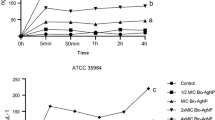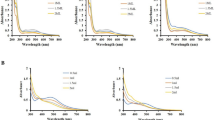Abstract
Silver nanoparticles, which are being used increasingly as antimicrobial agents, may extend its antibacterial application to methicillin-resistant Staphylococcus aureus (MRSA), the main cause of nosocomial infections worldwide. To explore the antibacterial properties of silver nanoparticles against MRSA, the present work includes an analysis of the relation between nanosilver effect and MRSA’s resistance mechanisms, a study of the size dependence of the bactericidal activity of nanosilver and a toxicity assessment of nanoparticles against epithelial human cells. Minimum inhibitory concentration (MIC), minimum bactericidal concentration (MBC), and MBC/MIC ratio of silver nanoparticles were quantified by using a luciferase-based assay. The cytotoxic effect (CC50 and CC90) of three different nanosilver sizes (10, 30–40, and 100 nm) were assessed in HeLa cells by a similar method. The therapeutic index was used as an indicator of nanosilver overall efficacy and safety. Silver nanoparticles inhibited bacterial growth of both MRSA and non-MR S. aureus in a bactericidal rather than a bacteriostatic manner (MBC/MIC ratio ≤ 4). Silver nanoparticle’s therapeutic index varied when nanoparticle’s size diminished. At the same dose range, 10 nm nanoparticles were the most effective since they did not affect HeLa’s cell viability while inhibiting a considerable percentage of MRSA growth. Silver nanoparticles are effective bactericidal agents that are not affected by drug-resistant mechanisms of MRSA. Nanosilver size mediates MRSA inhibition and the cytotoxicity to human cells, being smaller nanoparticles the ones with a better antibacterial activity and nontoxic effect.



Similar content being viewed by others
References
Velazquez-Meza ME. [Staphylococcus aureus methicillin-resistant: emergence and dissemination]. Salud Publica Mex. 2005;47:381–7.
Bustos-Martinez JA, Hamdan-Partida A, Gutierrez-Cardenas M. Staphylococcus aureus: la reemergencia de un patógeno en la comunidad. Rev Biomed. 2006;17:287–305.
World Health Organization. Monitoring of Antimicrobial Resistance. Report of an Intercountry Workshop; 2003 Oct 14–17; Tamil Nadu, India. 2004.
Klevens RM, Morrison MA, Nadle J, Petit S, Gershman K, Ray S, et al. Invasive methicillin-resistant Staphylococcus aureus infections in the United States. JAMA. 2007;298:1763–71.
Rai M, Yadav A, Gade A. Silver nanoparticles as a new generation of antimicrobials. Biotechnol Adv. 2009;27:76–83.
Li Y, Leung P, Yao L, Song QW, Newton E. Antimicrobial effect of surgical masks coated with nanoparticles. J Hosp Infect. 2006;62:58–63.
Elechiguerra JL, Burt JL, Morones JR, Camacho-Bragado A, Gao X, Lara HH, et al. Interaction of silver nanoparticles with HIV-1. J Nanobiotechnology. 2005;3:6.
Yoon KY, Byeon JH, Park JH, Ji JH, Bae GN, Hwang J. Antimicrobial Characteristics of Silver Aerosol Nanoparticles against Bacillus subtilis Bioaerosols. Environ Eng Sci. 2008;25:289–93.
Morones JR, Elechiguerra JL, Camacho A, Holt K, Kouri JB, Tapia J, et al. The bactericidal effect of silver nanoparticles. Nanotechnology. 2005;16:2346–53.
Shrivastava S, Bera T, Roy A, Singh G, Ramachandrarao P, Dash D. Characterization of enhanced antibacterial effects of novel silver nanoparticles. Nanotechnology. 2007;18:1–9.
Panacek A, Kvitek L, Prucek R, Kolar M, Vecerova R, Pizurova N, et al. Silver colloid nanoparticles: synthesis, characterization, and their antibacterial activity. J Phys Chem B. 2006;110:16248–53.
Birla SS, Tiwari VV, Gade AK, Ingle AP, Yadav AP, Rai MK. Fabrication of silver nanoparticles by Phoma glomerata and its combined effect against Escherichia coli, Pseudomonas aeruginosa and Staphylococcus aureus. Lett Appl Microbiol. 2009;48:173–9.
Inoue Y, Uota M, Torikai T, Watari T, Noda I, Hotokebuchi T, et al. Antibacterial properties of nanostructured silver titanate thin films formed on a titanium plate. J Biomed Mater Res A. 2009.
Lut L, Sun RW, Chen R, Hui CK, Ho CM, Luk JM, et al. Silver nanoparticles inhibit hepatitis B virus replication. Antivir Ther. 2008;13:253–62.
Tredget EE, Shankowsky HA, Groeneveld A, Burrell R. A matched-pair, randomized study evaluating the efficacy and safety of Acticoat silver-coated dressing for the treatment of burn wounds. J Burn Care Rehabil. 1998;19:531–7.
Jain P, Pradeep T. Potential of silver nanoparticle-coated polyurethane foam as an antibacterial water filter. Biotechnol Bioeng. 2005;90:59–63.
Hussain SM, Hess KL, Gearhart JM, Geiss KT, Schlager JJ. In vitro toxicity of nanoparticles in BRL 3A rat liver cells. Toxicol In Vitro. 2005;19:975–83.
Burd A, Kwok CH, Hung SC, Chan HS, Gu H, Lam WK, et al. A comparative study of the cytotoxicity of silver-based dressings in monolayer cell, tissue explant, and animal models. Wound Repair Regen. 2007;15:94–104.
Braydich-Stolle L, Hussain S, Schlager JJ, Hofmann MC. In vitro cytotoxicity of nanoparticles in mammalian germline stem cells. Toxicol Sci. 2005;88:412–9.
Arora S, Jain J, Rajwade JM, Paknikar KM. Cellular responses induced by silver nanoparticles: In vitro studies. Toxicol Lett. 2008;179:93–100.
Tian J, Wong KK, Ho CM, Lok CN, Yu WY, Che CM, et al. Topical delivery of silver nanoparticles promotes wound healing. Chem Med Chem. 2007;2:129–36.
Shin SH, Ye MK, Kim HS, Kang HS. The effects of nano-silver on the proliferation and cytokine expression by peripheral blood mononuclear cells. Int Immunopharmacol. 2007;7:1813–8.
Bhol KC, Schechter PJ. Topical nanocrystalline silver cream suppresses inflammatory cytokines and induces apoptosis of inflammatory cells in a murine model of allergic contact dermatitis. Br J Dermatol. 2005;152:1235–42.
Department of Health and Human Services, Centers for Disease Control. Detection of: Oxacillin/Methicillin-resistant Staphylococcus aureus. URL: http://www.cdc.gov/ncidod/dhqp/ar_lab_mrsa.html. Access date: Apr./14/2008.
Cleusix V, Lacroix C, Vollenweider S, Duboux M, Le Blay G. Inhibitory activity spectrum of reuterin produced by Lactobacillus reuteri against intestinal bacteria. BMC Microbiol. 2007;7:101.
Palavecino E. Clinical, Epidemiological, and Laboratory Aspects of Methicillin-Resistant Staphylococcus aureus (MRSA) Infections. In: Yinduo J, editor. Methicillin-Resistant Staphylococcus aureus (MRSA) Protocols. Humana Press; 2007. pp. 3–4.
McDonnell GE. Chemical Disinfection. In: Antisepsis, disinfection, and sterilization. 2007;111–5.
Starodub ME, Trevors JT. Silver resistance in Escherichia coli R1. J Med Microbiol. 1989;29:101–10.
Lok CN, Ho CM, Chen R, He QY, Yu WY, Sun H, et al. Proteomic analysis of the mode of antibacterial action of silver nanoparticles. J Proteome Res. 2006;5:916–24.
Sondi I, Salopek-Sondi B. Silver nanoparticles as antimicrobial agent: a case study on E. coli as a model for Gram-negative bacteria. J Colloid Interface Sci. 2004;275:177–82.
Pal S, Tak YK, Song JM. Does the antibacterial activity of silver nanoparticles depend on the shape of the nanoparticle? A study of the Gram-negative bacterium Escherichia coli. Appl Environ Microbiol. 2007;73:1712–20.
Murray PR, Rosenthal KS, Kobayashi GS, Pfaller MA. Medical Microbiology. In: MMII Mosby, Inc.: Spain; 2005. pp. 12–3.
Salton MRJ, Kim KS. Structure. In: Baron S, editor. Medical Microbiology. 2009.
Acknowledgments
This project was done with the economical support of the Programa de Apoyo a la Investigacion Cientifica y Tecnologica (PAICyT) of the Universidad Autonoma de Nuevo Leon, Mexico.
Author information
Authors and Affiliations
Corresponding author
Additional information
NV Ayala and HH Lara made equal contributions to this study.
Rights and permissions
About this article
Cite this article
Ayala-Núñez, N.V., Lara Villegas, H.H., del Carmen Ixtepan Turrent, L. et al. Silver Nanoparticles Toxicity and Bactericidal Effect Against Methicillin-Resistant Staphylococcus aureus: Nanoscale Does Matter. Nanobiotechnol 5, 2–9 (2009). https://doi.org/10.1007/s12030-009-9029-1
Published:
Issue Date:
DOI: https://doi.org/10.1007/s12030-009-9029-1




